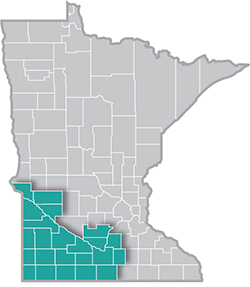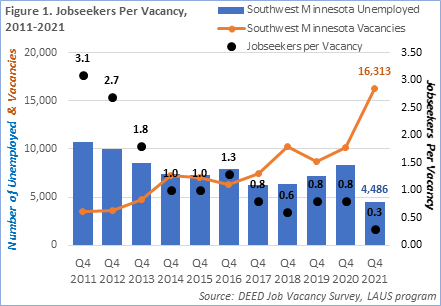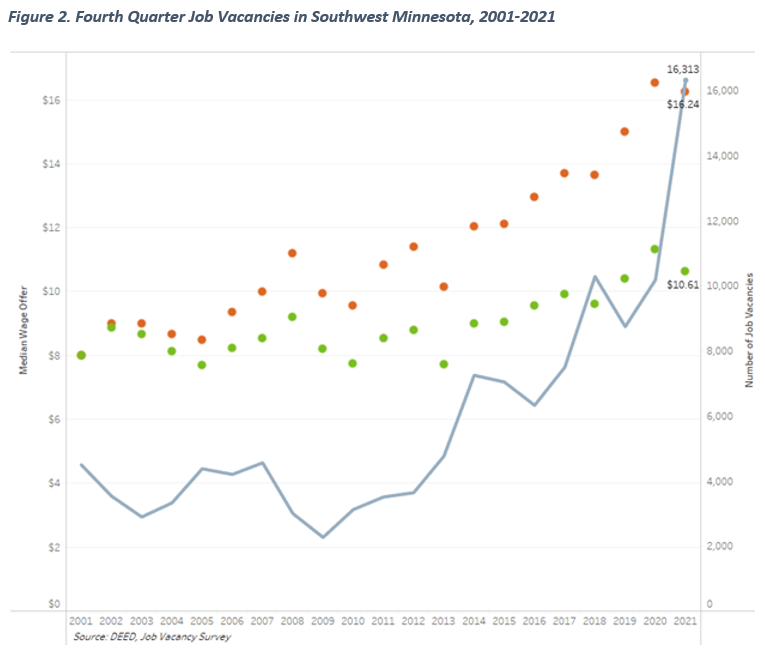 Southwest Minnesota is a national leader in agricultural production, and renewable energy.
Southwest Minnesota is a national leader in agricultural production, and renewable energy.
The region's thriving manufacturing sector includes food processing, machinery, printing, metal products, and computers and electronic products.
Want the freshest data delivered by email? Subscribe to our regional newsletters.
7/28/2022 9:00:00 AM
Luke Greiner
One of the trends that captures the unique labor market we are currently in is the steeply rising number of job vacancies. In the fourth quarter of 2021, the Southwest Minnesota region had just over 16,300 vacancies, eclipsing the pre-pandemic peak by more than 6,000 vacancies. With a job vacancy rate of 9.9%, Southwest has the highest job vacancy rate in the entire state, meaning for every 100 filled jobs, there are 9.9 unfilled jobs. Another way to think about this is in relation to those looking for work. At the end of 2021, there were three jobseekers for every ten open positions, the lowest such ratio in the 20 years of the Job Vacancy Survey, and a rapid drop over the past 10 years (see Figure 1).
 While most sectors experienced increases in vacancies, some saw larger gains than others. Compared to the fourth quarter of 2019, there were 7,573 more vacancies across all sectors, an 86% rise from pre-pandemic levels. More than half of that expansion can be attributable to Health Care & Social Assistance openings, which jumped by nearly 4,000 openings.
While most sectors experienced increases in vacancies, some saw larger gains than others. Compared to the fourth quarter of 2019, there were 7,573 more vacancies across all sectors, an 86% rise from pre-pandemic levels. More than half of that expansion can be attributable to Health Care & Social Assistance openings, which jumped by nearly 4,000 openings.
The next-largest two-year increases occurred in Retail Trade (+2,021), Wholesale Trade (+1,050), and Manufacturing (+953). Combined, those four sectors accounted for 70.6% of vacancies – and 51% of employment in 2021 – compared to only 40% of vacancies in fourth quarter 2019. Interestingly, Health Care & Social Assistance and Wholesale Trade both saw larger than average job losses which helped lead to even more openings, while Retail Trade and Manufacturing employers fared better than most sectors over the last two years and would like to continue hiring. Recovering as well as expanding sectors are looking to add workers in equal measure.
Accommodation & Food Services, one of the hardest hit sectors early in the pandemic, saw a corresponding decline in job vacancies between 2019 and 2020, from a record high of nearly 1,700 down to just over 760. A small rebound occurred the next year, but demand is still very measured in the industry as it struggles to fully recover. The Construction sector also saw a decline in vacancies, although to a lesser extent.
Wage offers are another indicator of how employers are reacting to trends in the labor market. Surprisingly, the median wage offer for all job vacancies declined over the year into the fourth quarter of 2021, down 1.8% or $0.29 to $16.24 per hour. That decrease followed a significant increase of more than $1.50 (+10%) from 2019 into 2020 (see Figure 2).

Over two years the largest wage offer growth occurred in Finance & Insurance (+33.5%), Wholesale Trade (+28.1%), and Transportation & Warehousing (+21.0%). Accommodation & Food Services, after seeing wage offers decline (-3.2%) between 2019 and 2020 along with the number of vacancies, saw a surge (+18%) in wage offers the following year. The more recent growth of wages reflects just one way that businesses are responding to increased competition for workers as well as rising prices.
Record numbers of job vacancies represent a healthy demand for workers, yet as they go unfilled it spells trouble for the long-term regional economy. Without large numbers of workers returning to the labor market or in-migration from other areas of the state, country and world, Southwest might not be able to recover to pre-pandemic employment for years. Rising wages are a way employers are trying to entice more workers back into the fold.
If employers could fill every current opening, the region's economy would be fully recovered and actually would exceed the previous employment peak by almost 7,000 jobs. Instead, there are more unfilled jobs in the region than ever – meaning that the region could be further along the road to recovery if it could find workers to fill these openings. This represents a great opportunity for people seeking to enter or re-enter the labor force.
Contact Labor Market Analysts Luke Greiner at 320-308-5378.